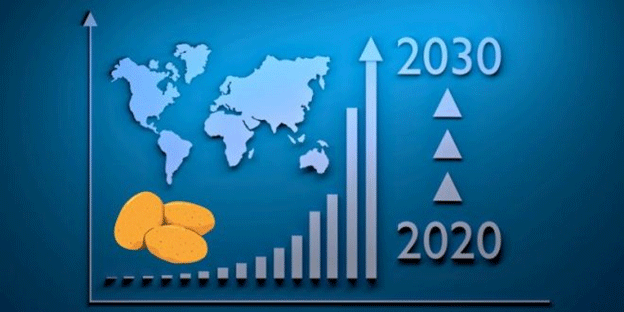One of the key findings from the study is that population growth will result in a natural increase in potato consumption. Over the study period, a 12% rise in population was linked to a “mechanical” increase in total potato demand. This growth, coupled with a shift towards processed foods, has further fueled the demand for both fresh and processed potatoes. Processed potato consumption is forecasted to rise by 70% under the “trend scenario,” with a compound annual growth rate (CAGR) of 6%, requiring an additional 45 million tonnes of potatoes for processing.
Alternatively, a slower economic scenario still predicts growth in processed potato consumption by 17%, with a CAGR of 2%, necessitating an increase of approximately 15 million tonnes for processing. In both cases, processed products are expected to take a larger share of total consumption, reflecting the modern consumer’s preference for convenience.
Per Capita Consumption: A Shift Towards Processed Potatoes
While overall consumption is increasing, per capita consumption trends show a shift towards processed products. The study estimates that the share of processed potatoes in total per capita consumption will rise from 27% to 39% by 2030. Fresh potato consumption, on the other hand, is expected to decline slightly. This transition reflects the growing influence of processed foods in daily diets, particularly in urban areas where convenience and fast food play a central role.
Production Must Adapt to Changing Consumption Patterns
The increase in potato demand will require production to keep pace. According to the study, the area dedicated to potato farming is expected to stabilize after years of decline, with production growth driven by improved yields rather than expanded acreage. Under the trend scenario, yields are expected to reach 24 tonnes per hectare by 2030, allowing the additional 45 million tonnes of potatoes required for processing to be produced without a significant increase in farmland.
However, achieving this growth depends on reducing global post-harvest losses, ensuring that more potatoes are allocated for human consumption (increasing from 67% to 70%). In contrast, the slowdown scenario forecasts overproduction, which could lead to price drops or contraction in cultivated areas. This scenario would see 15 million tonnes of additional production, creating a risk of market oversupply.
Impact of Climate Change on Potato Yields
A critical variable in the study’s projections is the potential impact of climate change. In a scenario where climatic hazards increase, global potato yields could stagnate at 21.5 tonnes per hectare, lower than expected trends. This would necessitate the expansion of potato farming by an additional 2 million hectares worldwide to meet demand. In regions vulnerable to climate fluctuations, such as parts of Asia and Africa, potato production could face significant challenges, requiring farmers to adapt their practices and invest in climate-resilient crop varieties.
Global Economic Growth and Regional Differences
The study also highlights the role of economic growth in shaping potato demand. Under optimistic economic conditions, countries like China, India, and Bangladesh are expected to lead the growth in potato production, contributing an additional 14 to 35 million tonnes. Emerging markets will add 7 to 9 million tonnes, while traditional potato-producing nations may see modest increases of 5 to 8 million tonnes.
Conversely, in countries where the potato economy is in decline, such as parts of Europe and North America, production could drop by as much as 13 to 16 million tonnes. This uneven growth will likely create tensions in global supply chains, with overproduction in some regions and shortages in others.
Preparing for the Future of Potato Farming
The 2022 study offers a comprehensive outlook on global potato consumption and production through 2030. While population growth and changing diets will drive higher demand, the sector must navigate challenges related to climate change, economic fluctuations, and regional disparities. To meet future needs, farmers will need to focus on improving yields, reducing losses, and adapting to new consumer preferences for processed products. In the face of these uncertainties, proactive planning and innovation in farming practices will be essential to ensuring a stable and prosperous future for the global potato industry.

